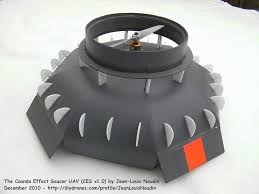As everybody is working on ways to improve electronic response I thought it was time I did a little work to see what can be done beyond the electric motor. Coanda and Bernoullis effect put to good use.
Looks interesting. Have you thought of enclosing the propellers in a cylinder? Operating more like a ducted fan, the propellers' thrust should, as far as I know, improve in efficiency as the enclosure limits wingtip vortices on the rotary wings (=props).
Just to explain the way in which air is drawn towards the center underside of the hull. As the laminar air flow produces low static pressure the flow of air is then disrupted to separate and create pressure recovery on the underside.
Bernoullis effect induces low pressure across the top surfaces and the coanda effect draws the downflow of air towards the underside of the hull creating a slightly higher pressure. As the lift is force x area then you don't need that much of a pressure differential to create some worthwhile extra lift.
An interesting bye product of all this could be a new concept of control. Consider this, if we want to move to the left say, then that would start with a bank to the left. But if we use another aerodynamic device known as a Gurney then that increase in thrust from the right side could also produce a sideways force that would push in the desired direction without all of that bank angle.
My next line of thought is to have some code that would give me a three axis camera stabilisation output that uses the 4x output from the IDG-500 - less than 1 us resolution. And then we would all have the best thing out there by miles. I do have a new camera mount design that uses the Hitec HS 5087MH 7.4Volt servos. By running the servos in continuous rotation with the pot locked up we get a fantastic stick response where the Camera mount moves faster as the stick moves away from neutral and slows down and stops when it returns to the neutral position. The camera stays in that last position and still stabilizes normally. This is simply the most natural way to steer a camera. I don't do code but I guess we have a few out there who could do this and take us to the very top.
Comments
Vibration, prop flutter? The prop blade tips are going into and out of different pressure zones,
curious if there is an increase in prop induced vibrations.
So .... this is the way the gain of efficiency is achive.
I find this an interesting combination of DIY and hands on physic concepts.
Bernoullis effect induces low pressure across the top surfaces and the coanda effect draws the downflow of air towards the underside of the hull creating a slightly higher pressure. As the lift is force x area then you don't need that much of a pressure differential to create some worthwhile extra lift.
An interesting bye product of all this could be a new concept of control. Consider this, if we want to move to the left say, then that would start with a bank to the left. But if we use another aerodynamic device known as a Gurney then that increase in thrust from the right side could also produce a sideways force that would push in the desired direction without all of that bank angle.
Yes I did test without the foam. and it gave the normal figs. that I have seen on the previous FMC designs.
The model balances exactly in the center of the X , note the position of the batteries (3) at the rear.
I am trying to imagine the propelor generated air flow and the way the foam use and change that air flow to any type off beneficial added effect.
Any idea .....
How does "your coanda" effect work (identifying components: Air flow, Curved surface, ...) ?
See JL Naudin Coanda Test Bench: http://jnaudin.free.fr/html/coanda.htm
A coanda project: The propeller is "pushing" velocity, surrounding curved surface, not pulling.
The propeller is "pushing" velocity, surrounding curved surface, not pulling.
-
1
-
2
-
3
of 3 Next